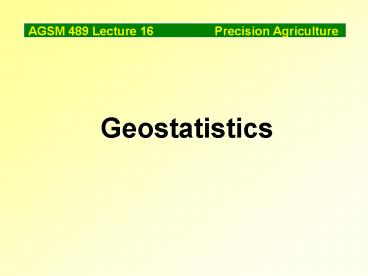Geostatistics PowerPoint PPT Presentation
1 / 21
Title: Geostatistics
1
Geostatistics
2
Agricultural fields often have spatial
relationships due to soils, topology or
management practices. Samples taken near each
other are more likely to be similar than samples
far apart.
3
Spatial relationships violate the underlying
assumptions of classical statistics samples can
be taken randomly from a population described by
a normal distribution.
4
Geostatistics are mathematical procedures to
recognize and describe spatial relationships that
might exist in a field. To recognize spatial
trends, the sample position is just as important
as the measured value.
5
Spatial trend example
Field transect
Value
Distance
6
In order to describe a spatial trend within a
field, multiple samples must be taken within the
range of that trend.
7
Apparent spatial trend
Field transect
Value
Distance
8
Soil Property Variability
Source Wollenhaupt, et al., 1997
9
Grid sampling ranges
- 1 ac/sample - 64 m
- 2.5 ac/sample - 100 m
- 4 ac/sample - 127 m
Common commercial sampling resolutions may not
adequately describe spatial relationships.
10
Spatial trends
- Isotropic - trend is a function of distance from
a known (sampled) point only - Anisotropic - trend is a function of both
distance and direction from a known point
11
Isotropic variability
- Variation in soil properties as function of
distance can be estimated by comparing samples at
a range of separation distances.
12
Sample pair distances
Each distance is called a lag (h).
13
Lag determination
The distance is calculated between all possible
sample pairs. For non-uniform sampling patterns,
the distances are assigned to a lag class for
calculation of the semivariance. eg 10-25 m,
25-50 m, etc.
14
Variability at each lag
Semivariance (?) is calculated to describe the
expected deviation from sample values (z) as a
function of distance (h) between sample pairs.
15
Semivariance vs. lag
16
Semivariogram
A mathematical model of the semivariance as a
function of lag is called a semivariogram. The
model is normally determined by least squares
regression.
17
Semivariogram models
- Linear - ?(h) C0bh
- Spherical -
- ?(h) C0C11.5(h/a)-0.5(h/a)3
- Exponential -
- ?(h) C0C11-e(-h/a)
- C - coefficients, a - range
18
Semivariogram
Range
Sill
Nugget
19
Semivariogram descriptors
- Nugget - variability at zero distance, represents
sampling and analytical errors - Range - the extent of spatial trends, distance
beyond which sampling is random - Sill - variability of spatially independent
samples
20
Semivariogram
Spatially dependent
Spatially independent
21
Semivariogram uses
- Use range to determine maximum sampling distances
- The sill indicates intra-field variability
- The model can be used for interpolation of values
in unsampled areas

